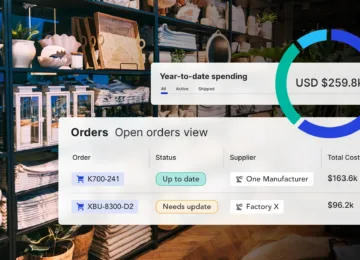Supply chains have owned much of the public’s mindshare these past few years. From the infamous Suez Canal blockage that stalled Asia-Europe shipping trade lanes for six days in 2021, to the pandemic’s colossal impact on the movement of materials, there’s been a huge amount of focus on the fragility of global supply chains.
A cohort that’s especially felt the wrath of these events are small and mid-sized businesses (SMBs). Indeed, they’ve faced a particularly acute impact from Covid-19 in the form of staffing challenges, consumer shifts and materials shortages, all of which have deteriorated the reliability of their supply chain.
To dig deeper into these issues and challenges, as well as highlight the opportunities that exist for businesses during this current digital transformation, Anvyl commissioned a study to 400+ owners and C-suite level executives of businesses with less than 1,000 employees across industries, including retail, ecommerce, technology, manufacturing, and more.
In our Supply Chain Outlook 2023, we found that 79% of businesses have suffered consequences due to supply chain disruptions since the onset of the pandemic. Of course, one of the most impactful consequences of pandemic-induced supply chain disruptions has been delays. Our research found that 31% of SMBs report losing between 7% and 15% of revenue due to delays in 2022, with an additional 29% reporting losses of 15% or greater.
The good news is that there’s also been an emergence of new technologies to help businesses overcome these challenges by modernizing supply chain management. Before we offer tips on how to maximize the potential of these new solutions, let’s take a closer look at the increasing complexity of SMB supply chains.
Increasing Complexity of SMB Supply Chains
Managing supply chains has always been a critical part of doing business as an SMB. Even more so than larger businesses, a delayed shipment or failed order can destroy their financial health. To analyze the impact of such challenges on SMBs, the U.S. Chamber of Commerce conducted research that found that nearly half (47%) currently find it hard to keep up with customer demand due to disruptions in their supply chain.
Stats like this highlight how important it is for small to medium-sized businesses to have control over their supply chain – especially when you consider how robust their supplier base is. Of the SMBs Anvyl surveyed, 50% reported using 26 or more suppliers, with 37% using 50 or more.
Of course, when you’re dealing with this number of suppliers, managing your orders becomes a lot more tricky. Anvyl also found that nearly two-thirds (64%) issue 25 or more purchase orders per month, with 40% issuing 50 or more orders on a monthly basis. In order to keep track of these orders and ensure their successful delivery, it necessitates efficient communication – and a lot of it.
Businesses are turning to remote solutions that support collaboration to help with this. In fact, 30% of the respondents we surveyed report using four or more tools/channels for collaboration/communication between their team members and partners.
One would be remiss to discuss the increasing complexity of supply chains, however, without mentioning the severity of the staffing challenges they’re dealing with, as well as the budget cuts they’ve had to implement to respond to a rocky economic climate. The reality is when you’re operating with these challenges as a backdrop, supply chain management becomes much more difficult. But there are ways to optimize how you manage your supply chain.
5 Tips for Successful Supply Chain Management
1. Establish Clear Communication Channels and Protocols
You shouldn’t need to use four communication channels to keep tabs on your suppliers. Using this many will just cause confusion and potentially open yourself up to more errors. After all, there’s a strong probability that every order you submit will be amended in some way. According to our proprietary data, of all purchase orders that shipped in 2022, 56% were changed at least once during their lifecycle. That’s a lot of changes to keep track of – and a lot of back and forth between you and your supplier.
For our recommended alternative, see our next tip.
2. Implement a Centralized Supply Chain Relationship Management System
For more efficient communication and supply chain management in general, we recommend using one supply chain relationship management (SCRM) tool as your single source of truth. SCRMs let suppliers input updates directly into the platform and collaborate with you on any unexpected surprises – eliminating the need to keep cross-referencing information across emails, phone call notes, texts, and faxes. In fact, when we explored the state of supplier-buyer communications in 2020, we found that communication was 3x more efficient when using an SCRM!
In addition to solving these communication challenges, SCRM software address another major pain point in the production process: document management. Approving and updating purchase orders can be an incredibly time-consuming job – especially if there have been changes to PO quantities, production specifications, or lead times. Today’s most effective SCRM systems automate this process, freeing supply chain managers and professionals up to focus on the tasks that need more of a human touch. Which brings us to our next point.
3. Invest in Technology to Improve Automation and Data Analysis
89% of SMB owners and C-suite executives we surveyed say they are planning to make strategic investments in their supply chain management in 2023. This is a positive sign, as not only does it suggest that leaders have an understanding of the major issues plaguing their supply chain, but they’re also actively allocating resources to fix them.
For SMBs, one of these issues is how unpredictable their supply chain can be. Unfortunately, they don’t have the same resources as larger companies that can hire additional talent to help manage their supply chain. This is why automation and data analysis are so important for SMBs, as they empower them to do more with less and inject that much needed dose of predictability into their supply chain.
4. Conduct Regular Supplier Audits and Risk Assessments
When you’re operating in a landscape as competitive as ecommerce, just one supplier mistake or oversight can leave a detrimental mark on your brand’s reputation and bottom line. With this in mind, it’s critical that you conduct regular supplier audits to monitor the quality of your vendors and suppliers.
According to our report, over half (56%) of SMBs have had to change a supplier within the past year, with “costs” and “consistent delays” being the top two reasons why. This highlights the growing need for continuous audits and risk assessments. Not only are they the key to identifying potential risk areas before they disrupt your supply chain, but they can also help you improve your supplier relationships and customer satisfaction, too.
5. Develop a Contingency Plan for Supply Chain Disruptions
Some supply chain disruptions are unavoidable, however. And when they do happen, you need to be able to respond quickly. Indeed, having a contingency plan in place is one of the most important steps you can take towards building a more resilient supply chain. Consider planning, testing, and updating your contingency strategy regularly. Moreover, leverage your data to inform your decisions, anticipate trends, and ask proactive questions of your suppliers to ensure everyone is working together seamlessly.
Modernizing Supply Chain Management
We’d bet that what worked for your supply chain management process five years ago doesn’t work today. The global supply chain is evolving at an incredibly fast pace, a fact that’s requiring SMBs’ management systems to undergo their own transformation. It’s a call to action they simply can’t ignore. The past few years have highlighted this, with organizations’ supply chains put to the ultimate test.
Modernizing your supply chain management process, however, also means taking control of it. Indeed, the emergence of new technologies – like Anvyl – that act as a single source of truth for a business’s supply chain is also helping them improve supplier relationships, streamline important business practices, and monitor and manage their robust supply chain. Take action now to modernize your supply chain by contacting Anvyl to discover how we can help bring your business processes to the next level.



